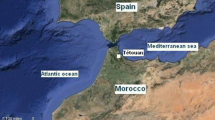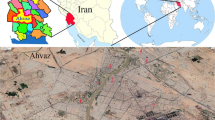Abstract
Airborne particles (pollens and fungal spores) are recognized as important causes of allergies and many other pathologies whose main symptoms are usually associated with respiratory problems. In addition, these particles seem to be responsible for clinical symptoms of oculorhinitis and bronchial asthma. Many authors showed how pollen and spore concentrations are critically linked to meteorological conditions, while other studies investigated the possibility to estimate these concentrations through meteorological parameters. So, many different approaches have been proposed, and one of the most sophisticated is based on the use of a complex artificial neural network architecture. Once the neural device is calibrated using simultaneous time series of observed meteorological parameters and airborne biological particles, it is straightforward to use the Neural Network to predict spore concentrations using operational Limited Area Meteorological Model. In a previous work, it has been shown that the MM5 meteorological model developed by National Center for Atmospheric Research and Pennsylvania State University can be coupled with the above-cited neural predictor to provide a good prediction of Alternaria and Pleospora spore in the location of L’Aquila (Central Italy). Following the same approach, this work aims to provide the mapping of spore concentration over a wide area covered by high-resolution meteorological prediction in Central Italy. The complex patterns of fungal spore concentrations in selected areas will be described, and the high temporal variability of such fields will be discussed as well. The possibility to infer useful information from the predicted pattern of spore concentrations is discussed, as an example it appears that for people suffering from allergy to fungal spores is more comfortable to spend summertime close to the east coast of Italian Peninsula respect to the west coast. A further step of this work may easily lead to an operational use of the model for supporting the clinical management of allergies and for establishing a preventive strategy in agriculture to avoid unsafe and useless pollution of atmosphere, crops and fields.









Similar content being viewed by others
References
Abdel Hameed, A. A. (2005). Vegetation: A source of air fungal bio-contaminant. Aerobiologia, 21, 53–61.
Angelosante Bruno, A., Pace, L., Tomassetti, B., Coppola, E., Verdecchia, M., Pacioni, G., et al. (2007). Estimation of fungal spore concentrations associated to meteorological variables. Aerobiologia, 23, 221–228.
Astray, G., Rodríguez-Rajo, F. J., Ferreiro-Lage, J. A., Fernández-González, M., Jato, V., & Mejuto, J. C. (2010). The use of artificial neural networks to forecast biological atmospheric allergens or pathogens only as Alternaria spores. Journal of Environmental Monitoring, 12(11), 2145–2152.
Bartra, J., Belmonte, J., Torres-Rodríguez, J. M., & Cistero-Bahima, A. (2009). Sensitization to Alternaria in patients with respiratory allergy. Front Bioscience, 14, 3372–3379.
Beggs, P. J. (2009). Plant food allergens: Another climate change–public health link. Environ Health Perspect, 117, A191–A191. http://dx.doi.org/10.1289/ehp.0900670.
Bernard, S. M., Samet, J. M., Grambsch, A., Ebi, K. L., Romieu, I. (2001). The potential impacts of climate variability and change on air pollution-related health effects in the United States. Environmental Health Perspectives, 109(Suppl 2), 199–209.
Bianco, L., Tomassetti, B., Coppola, E., Fracassi, A., Verdecchia, M., & Visconti, G. (2006). Thermally driven circulation in a region of complex topography: Comparison of wind-profiling radar measurements and MM5 numerical predictions. Annales Geophysicae, 24, 1537–1549.
Burch, M., & Levetin, E. (2002). Effects of meteorological conditions on spore plumes. International Journal of Biometeorology, 46, 107–117.
Corden, J. M., Millington, W. M., & Mullins, J. (2003). Long-term trends and regional variation in the aeroallergen Alternaria in Cardiff and Derby UK – are differences in climate and cereal production having an effect? Aerobiologia, 19(3–4), 191–199. doi:10.1023/B:AERO.0000006529.51252.2f.
Dudhia, J. (1993). A non-hydrostatic version of the Penn State/NCAR mesoscale model: Validation test and simulation of an Atlantic cyclone and cold front. Monthly Weather Review, 121, 1493–1513.
Elman, L. J. (1990). Finding structure in time. Cognitive Science, 14, 179–211.
Escuredo, O., Seijo, M. C., Fernández-González, M., & Iglesias, I. (2011). Effects of meteorological factors on the levels of Alternaria spores on a potato crop. International Journal of Biometeorology, 55(2), 243–252. doi:10.1007/s00484-010-0330-4.
Frenguelli, G. (1998). The contribution of aerobiology to agriculture. Aerobiologia, 14, 95–100.
Giner, M. M., & Carrión-García, J. S. (1995). Daily variations of Alternaria spores in the city of Murcia (semi-arid south eastern of Spain). International Journal of Biometeorology, 38, 176–179.
Gioulekas, D., Damialis, A., Papakosta, D., Spieksma, F., Giouleka, P., & Patakas, D. (2004). Allergenic fungi spore records (15 years) and sensitization in patients with respiratory allergy in Thessaloniki-Greece. Journal of Investigational Allergology and Clinical Immunology, 14(3), 225–231.
Grell, G. A., Dudhia, J., & Stauffer, D. R. (1994). A description of the fifth generation Penn State/NCAR Mesoscale Model (MM5). NCAR Technical Note, NCAR/TN-398 + STR, 121.
Grinn-Gofroń, A., & Mika, A. (2008). Selected airborne allergenic fungal spores and meteorological factors in Szczecin, Poland, 2004–2006. Aerobiologia, 23(2), 89–97. doi:10.1007/s10453-008-9088-0.
Grinn-Gofroń, A., Strzelczak, A., & Wolski, T. (2011). The relationships between air pollutants, meteorological parameters and concentration of airborne fungal spores. Environmental Pollution, 159(2), 602–608.
Hanlin, R. T. (1990). Illustrated genera of Ascomycetes (pp. 226–227). St. Paul, Minnesota: The American Phytopathological Society.
Hecht-Nielsen, R. (1991). Neurocomputing. Reading: Addison Wesley Publishing Company.
Herrero, B., Fombella-Blanco, M. A., Fernández-González, D., & Valencia-Barrera, R. M. (1996). The role of meteorological factors in determining the annual variation of Alternaria and Cladosporium spores in the atmosphere of Palencia, 1990–1992. International Journal of Biometeorology, 39, 139–142.
Hirst, J. M. (1952). An automatic volumetric spore trap. Annals of Applied Biology, 39, 257–265.
Hjelmroos, M. (1993). Relationship between airborne fungal spore presence and weather variables. Grana, 32, 40–47.
Hollins, P. D., Kettlewell, P. S., Atkinson, M. D., Stephenson, D. B., Corden, J. M., Millington, W. M., et al. (2004). Relationships between airborne fungal spore concentration of Cladosporium and the summer climate at two sites in Britain. International Journal of Biometeorology, 48, 137–141.
Kain, J. S., & Fritsch, J. M. (1990). A one-dimensional entraining/detraining plume model and its application in convective parameterization. Journal of Atmospheric Science, 47, 2784–2802.
Lombladd, L., Peterson, C., & Röngvaldsson, T. (1992). Pattern recognition in high energy physics with artificial neural network—Jetnet 2.0. Computer Physics Communications, 70, 167–182.
Mandrioli, P., Comtois, P., & Levizzani, V. (1998). Methods in aerobiology. Bologna: Pitagora Editrice.
Mari, A., Shneider, P., Wally, V., Breitenbach, M., & Simon-Nobbe, B. (2003). Sensitization to fungi: Epidemiology, comparative skin tests, and IgE reactivity of fungal extracts. Clinical and Experimental Allergy, 33, 1429–1438.
Mitakakis, T. Z., & Guest, D. I. (2001). A fungal spore calendar for the atmosphere of Melbourne, Australia, for the year 1993. Aerobiologia, 17, 171–176.
Oliveira, M., Ribeiro, H., Delgado, J. L., & Abreu, I. (2009). The effects of meteorological factors on airborne fungal spore concentration in two areas differing in urbanisation level. International Journal of Biometeorology, 53(1), 61–73. doi:10.1007/s00484-008-0191-2.
Paolucci, T., Bernardini, L., Ferretti, R., & Visconti, G. (1999). MM5 real-time forecast of a catastrophic event on May, 5 1998. Il Nuovo Cimento, 12, 727–736.
Recio, M., Del Mar Trigo, M., Docampo, S., Melgar, M., García-Sánchez, J., Bootello, L., & Cabezudo, B. (2011). Analysis of the predicting variables for daily and weekly fluctuations of two airborne fungal spores: Alternaria and Cladosporium. International Journal of Biometeorology. doi:10.1007/s00484-011-0509-3.
Rodrìguez-Rajo, F. J., Iglesias, I., & Jato, V. (2005). Variation assessment of airborne Alternaria and Cladosporium spores at different bioclimatical conditions. Mycological Research, 109(4), 497–507. doi:10.1017/S0953756204001777.
Sabariego, S., Diaz De la Guardia, C., & Alba, F. (2000). The effects of meteorological factors on the daily variation of airborne fungal spores in Granada (southern Spain). International Journal of Biometeorology, 44, 1–5.
Srivastava, A. K., & Wadhwani, K. (1992). Dispersion and allergenic manifestation of Alternaria airspora. Grana, 31, 61–66.
Staub, T. (1991). Fungicide resistance: Practical experience with antiresistance strategies and the role of integrated use. Annual review of Phytopathology, 29, 421–442.
Stennett, P. J., & Beggs, P. J. (2004). Alternaria spores in the atmosphere of Sydney, Australia, and relationships with meteorological factors. International Journal of Biometeorology, 49, 98–105.
Stephen, E., Raffery, A. E., & Dowding, P. (1990). Forecasting spore concentrations: A time series approach. International Journal of Biometeorology, 34, 87–89.
Tomassetti, B., Angelosante Bruno, A., Pace, L., Verdecchia, M., & Visconti, G. (2009). Prediction of Alternaria and Pleospora concentrations from the meteorological forecast and artificial neural network in L’Aquila, Abruzzo (Central Italy). Aerobiologia, 25, 127–136.
Tomassetti, B., Giorgi, F., Verdecchia, M., & Visconti, G. (2003). Regional model simulation of hydrometeorological effects of the Fucino Lake on the surrounding region. Annales Geophysicae, 25, 127–136.
Troen, I., & Mahrt, L. (1986). A simple model of the atmosphere boundary layer: Sensitivity to surface evaporation. Boundery-Layer Meteorology, 37, 129–148.
Zhang, D. L., Chang, H. R., Seaman, N. L., Warner, T. T., & Fritsch, J. M. (1986). A two-way interactive nesting procedure with variable terrain resolution. Monthly Weather Review, 114, 1330–1339.
Author information
Authors and Affiliations
Corresponding author
Rights and permissions
About this article
Cite this article
Tomassetti, B., Lombardi, A., Cerasani, E. et al. Mapping of Alternaria and Pleospora concentrations in Central Italy using meteorological forecast and neural network estimator. Aerobiologia 29, 55–70 (2013). https://doi.org/10.1007/s10453-012-9262-2
Received:
Accepted:
Published:
Issue Date:
DOI: https://doi.org/10.1007/s10453-012-9262-2




